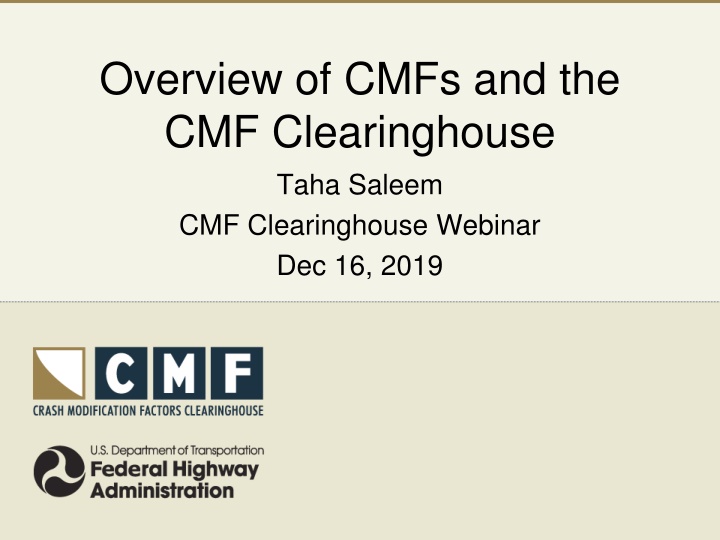
CMF Clearinghouse and Effective CMF Implementation
Learn about CMF Clearinghouse, the importance of selecting and applying CMFs correctly, dealing with multiple search results, differentiating between CMFs for the same crash type, using the compare CMFs tool, and calculating reverse treatment effects in transportation studies.
Download Presentation

Please find below an Image/Link to download the presentation.
The content on the website is provided AS IS for your information and personal use only. It may not be sold, licensed, or shared on other websites without obtaining consent from the author. If you encounter any issues during the download, it is possible that the publisher has removed the file from their server.
You are allowed to download the files provided on this website for personal or commercial use, subject to the condition that they are used lawfully. All files are the property of their respective owners.
The content on the website is provided AS IS for your information and personal use only. It may not be sold, licensed, or shared on other websites without obtaining consent from the author.
E N D
Presentation Transcript
Overview of CMFs and the CMF Clearinghouse Taha Saleem CMF Clearinghouse Webinar Dec 16, 2019
Introduction Selecting an appropriate CMF is important Applying CMFs correctly is important as well can have large impact on results CMF Clearinghouse team is available to help explain CMFs on the site or from a study report
DEALING WITH TOO MANY SEARCH RESULTS
116 Results 357 Results 219 Results
MULTIPLE CMFSFORTHE SAME CRASH TYPE AND SEVERITYINA STUDY HOWTODIFFERENTIATE?
CALCULATINGTHE REVERSE TREATMENTEFFECT
Reverse Treatment Effect Research study indicates a CMF of 1.48 for a 75 degree intersection compared to a 90 degree intersection What is the reasonable assumption of CMF for realigning an intersection to 90 degrees?
Reverse Treatment Effect Mistake: assuming that a 1.48 CMF would lead to a 52% reduction in crashes (presumably because 2.0-1.48=0.52?) CMF = (CMF for new condition) / (CMF for old condition) = (CMF for 90 degrees) / (CMF for 75 degrees) = 1.00 / 1.48 = 0.68. This represents an expected 32% reduction in crashes (100-100x0.68 = 32), not 52%
APPLYINGTOOMANY CMFS WITHOUTACCOUNTINGFOR INTERRELATIONSHIPOFEFFECT
Applying too many CMFs without accounting for interrelationship of effect CMFs may address the same crash type For example, addressing run off road crashes at curves Chevrons Wider edgelines High friction surfacing The effects are related (not independent)
Applying too many CMFs without accounting for interrelationship of effect Multiplying CMFs together likely overstates benefit, especially when considering many countermeasures A tool (or analyst) must account for interrelationship of effect Conservative: Use CMF from only the most effective treatment More discussion on this topic in the next presentation
Q&A Enter questions using the GoToWebinar window
